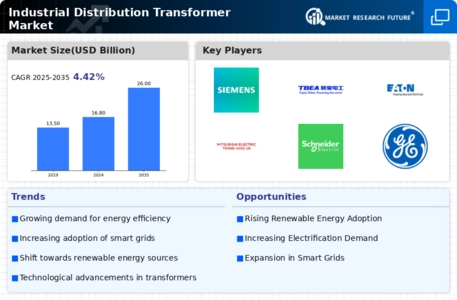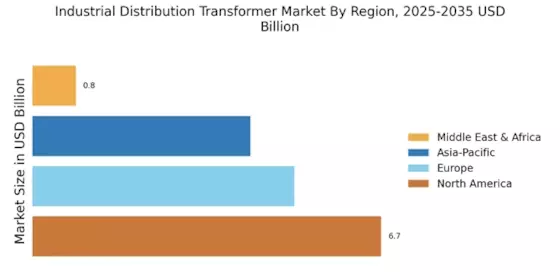Rising Demand for Renewable Energy
The increasing emphasis on renewable energy sources is driving the Industrial Distribution Transformer Market. As countries strive to meet energy transition goals, the integration of renewable energy systems, such as solar and wind, necessitates efficient distribution transformers. These transformers are essential for managing the variable output from renewable sources, ensuring stable power supply. The market for renewable energy is projected to grow significantly, with investments in solar and wind energy expected to reach trillions of dollars in the coming years. This shift towards cleaner energy sources is likely to enhance the demand for advanced distribution transformers that can handle the unique challenges posed by renewable energy integration.
Infrastructure Development Projects
Infrastructure development projects are a key driver of the Industrial Distribution Transformer Market. Governments and private sectors are investing heavily in upgrading and expanding electrical infrastructure to support growing urban populations and industrial activities. The demand for reliable power supply in new residential, commercial, and industrial developments is increasing the need for distribution transformers. According to recent estimates, infrastructure investments are expected to exceed several trillion dollars over the next decade, creating a substantial market for distribution transformers. This trend indicates a robust growth trajectory for the Industrial Distribution Transformer Market as new projects emerge globally.
Regulatory Support for Energy Efficiency
Regulatory support for energy efficiency is a significant driver of the Industrial Distribution Transformer Market. Governments worldwide are implementing stringent regulations aimed at reducing energy consumption and greenhouse gas emissions. These regulations often mandate the use of high-efficiency transformers in new installations and upgrades. As a result, manufacturers are compelled to innovate and produce transformers that meet these efficiency standards. The market for energy-efficient transformers is projected to grow as compliance with these regulations becomes increasingly critical for utilities and industrial operators. This regulatory landscape is likely to foster a competitive environment, pushing for advancements in transformer technology.
Growth of Electric Vehicle Infrastructure
The growth of electric vehicle (EV) infrastructure is emerging as a vital driver for the Industrial Distribution Transformer Market. As the adoption of electric vehicles accelerates, the demand for charging stations is surging. These charging stations require robust electrical infrastructure, including distribution transformers, to ensure efficient power delivery. The expansion of EV charging networks is expected to require substantial investments, potentially reaching hundreds of billions of dollars in the next few years. This trend not only supports the transition to sustainable transportation but also creates a burgeoning market for distribution transformers tailored to meet the specific needs of EV charging applications.
Technological Innovations in Transformer Design
Technological innovations in transformer design are significantly influencing the Industrial Distribution Transformer Market. Advances in materials and engineering have led to the development of more efficient and compact transformers. These innovations not only enhance performance but also reduce energy losses, which is crucial in an era where energy efficiency is paramount. The introduction of smart transformers, equipped with monitoring and control capabilities, is also gaining traction. These smart devices can optimize energy distribution and improve grid reliability. As the demand for smarter energy solutions grows, the market for technologically advanced distribution transformers is likely to expand, reflecting a shift towards more intelligent energy management systems.


















Leave a Comment